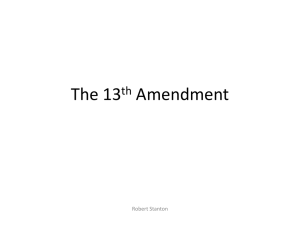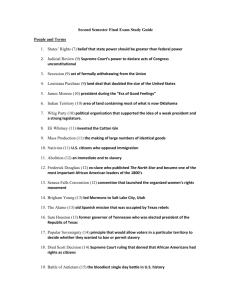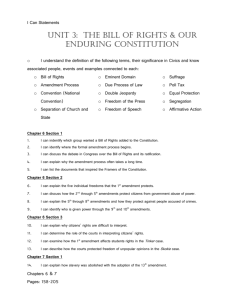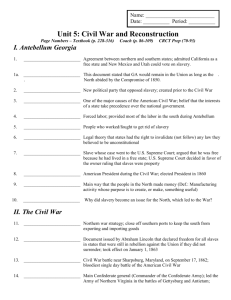MULTIPLE CHOICE. Choose the one alternative that
advertisement
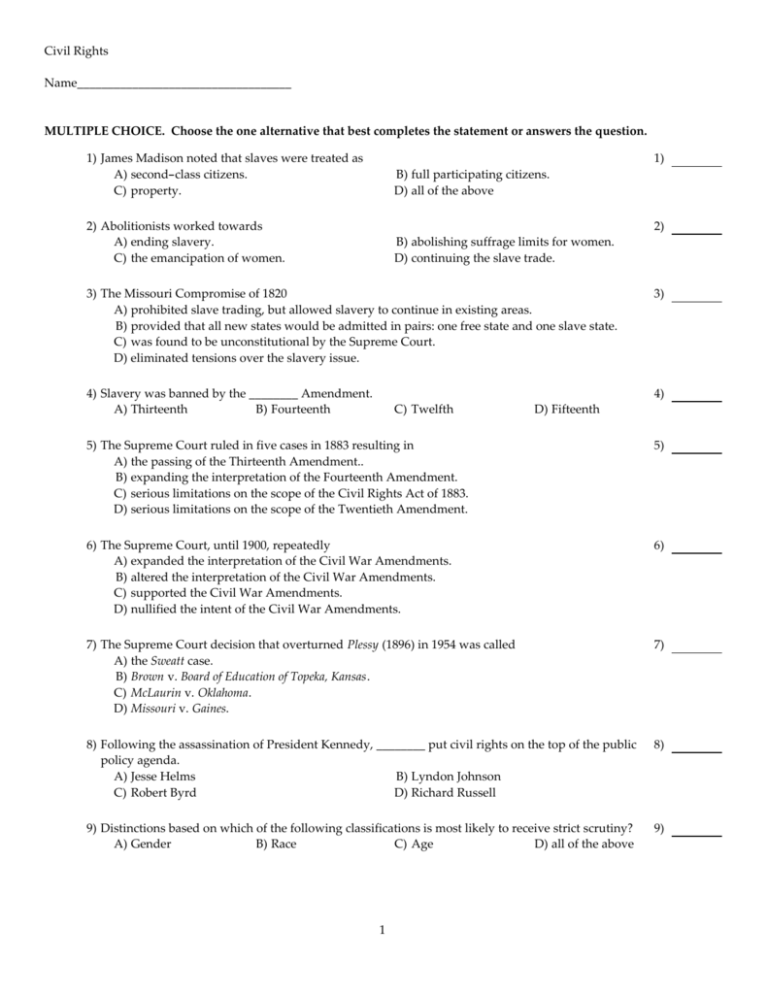
Civil Rights Name___________________________________ MULTIPLE CHOICE. Choose the one alternative that best completes the statement or answers the question. 1) James Madison noted that slaves were treated as A) second-class citizens. C) property. 1) B) full participating citizens. D) all of the above 2) Abolitionists worked towards A) ending slavery. C) the emancipation of women. 2) B) abolishing suffrage limits for women. D) continuing the slave trade. 3) The Missouri Compromise of 1820 A) prohibited slave trading, but allowed slavery to continue in existing areas. B) provided that all new states would be admitted in pairs: one free state and one slave state. C) was found to be unconstitutional by the Supreme Court. D) eliminated tensions over the slavery issue. 3) 4) Slavery was banned by the ________ Amendment. A) Thirteenth B) Fourteenth 4) C) Twelfth D) Fifteenth 5) The Supreme Court ruled in five cases in 1883 resulting in A) the passing of the Thirteenth Amendment.. B) expanding the interpretation of the Fourteenth Amendment. C) serious limitations on the scope of the Civil Rights Act of 1883. D) serious limitations on the scope of the Twentieth Amendment. 5) 6) The Supreme Court, until 1900, repeatedly A) expanded the interpretation of the Civil War Amendments. B) altered the interpretation of the Civil War Amendments. C) supported the Civil War Amendments. D) nullified the intent of the Civil War Amendments. 6) 7) The Supreme Court decision that overturned Plessy (1896) in 1954 was called A) the Sweatt case. B) Brown v. Board of Education of Topeka, Kansas. C) McLaurin v. Oklahoma. D) Missouri v. Gaines. 7) 8) Following the assassination of President Kennedy, ________ put civil rights on the top of the public policy agenda. B) Lyndon Johnson A) Jesse Helms C) Robert Byrd D) Richard Russell 8) 9) Distinctions based on which of the following classifications is most likely to receive strict scrutiny? A) Gender B) Race C) Age D) all of the above 9) 1 10) Which of the following decisions was the biggest victory for gay rights? A) City of Cleburne v. Cleburne Living Center B) Los Angeles Times v. MALDEF C) Craig v. Boren D) Lawrence v. Texas 10) 11) The Supreme Court upheld the constitutionality of the Civil Rights Act of 1964 by referring to A) Article III of the Constitution. B) Article II of the Constitution. C) Article VI of the Constitution. D) Article I of the Constitution. 11) 12) In 1964, a full decade after Brown v. Board of Education, ________ percent of African-American children in the South attended integrated schools. A) 10 B) fewer than 1 C) 25 D) more than 50 12) 13) Racial discrimination that results from practice rather than law is called ________ discrimination. A) de facto B) de jure C) practical D) direct 13) 14) The Equal Rights Amendment failed in A) 1995. B) 1978. 14) C) 1982. D) 1972. 15) In 1955, the Montgomery bus boycott began with the intent of ending segregation on public transport. The catalyst for the boycott was a black person who was arrested for refusing to give up a seat to a white person. The name of this person was A) Linda Brown. B) Martin Luther King, Jr. C) Rosa Parks. D) W.E.B. DuBois. 15) 16) In 1955, a number of black leaders, including Martin Luther King, Jr., established a new group to help continue the Montgomery bus boycott. This group was called the A) Montgomery Improvement Association.. B) Student Nonviolent Coordinating Committee (SNCC). C) Southern Christian Leadership Conference (SCLC). D) National Association for the Advancement of Colored Persons (NAACP). 16) 17) Among the tactics used by the civil rights movement were A) freedom rides. B) lawsuits. C) sit-ins and boycotts. D) all of the above 17) 18) In August 1963, Martin Luther King, Jr. led a huge march on ________ that culminated in his ʺI Have a Dreamʺ speech. A) Washington B) Atlanta C) Birmingham D) Montgomery 18) 19) Which of the following best describes public opinion about affirmative action? A) More Americans favor affirmative action than oppose it. B) Most Americans have never heard of affirmative action. C) Less than 10% of African American are in favor of affirmative action. D) All of the above. 19) 20) The Suffrage Movement A) promoted voting rights for blacks. C) had racist overtones. 20) B) promoted broad social issues. D) all of the above 2 21) Women finally received the right to vote in 1920 through the ________ Amendment. A) Twenty-first B) Twenty-second C) Nineteenth D) Twenty-fifth 21) 22) When the NAACP began its litigation strategy to end segregation, it chose to begin by challenging segregation in A) public accommodations. B) transportation. C) professional and graduate schools. D) elementary schools. 22) 23) Laws enacted by southern states that resulted in segregation by race were also known as A) grandfather rules. B) Black Codes. D) all of the above C) Jim Crow laws. 23) 24) The Supreme Court ruling in Plessy v. Ferguson was ________ in favor of separate but equal. A) 8-1 B) 9-0 C) 6-3 D) 5-4 24) 25) In ________, the Supreme Court found that segregation of rail transportation was constitutional because separate but equal accommodations did not violate the equal protection clause of the Fourteenth Amendment. A) the Civil Rights cases B) Bradwell v. Illinois C) Plessy v. Ferguson D) the Slaughterhouse cases 25) 26) In Eyes of the Prize, Juan Williams wrote, A) ʺthere were Jim Crow schools.ʺ B) ʺblacks were supposed to tip their hats.ʺ C) ʺwhites did not have to remove their hats even when they entered a black familyʹs home.ʺ D) all of the above 26) 27) The Thirteenth, Fourteenth, and Fifteenth Amendments are collectively known as the A) Constitution. B) Civil War Amendments. C) Bill of Rights. D) civil liberties amendments. 27) 28) Laws that denied most legal rights to newly freed slaves and prohibited blacks from voting, sitting on juries, or even appearing in public places after the Civil War were known as A) Abolitionism. B) Black Codes. D) nullification rules. C) Jim Crow laws. 28) 29) The first time Congress ever passed an override of a presidential veto occurred over the A) Missouri Compromise. B) Black Codes. C) Emancipation Proclamation. D) Civil Rights Act of 1866. 29) 30) Former slaves were granted citizenship as well as the ʺprivileges and immunitiesʺ thereof, and states barred from depriving anyone of ʺlife, liberty or property without due process of lawʺ through the ________ Amendment. A) Twelfth B) Fifteenth C) Fourteenth D) Thirteenth 30) 31) The first major civil rights case to be considered by the Supreme Court dealt with a dispute over the constitutionality of the A) Civil Rights Act of 1866. B) Missouri Compromise. C) Civil War Amendments. D) Black Codes. 31) 3 32) The Emancipation Proclamation A) freed all slaves in the Confederacy. C) freed all slaves. B) limited slave ownership in the west. D) limited slave ownership in the north. 32) 33) Congress banned the slave trade in A) 1848. B) 1820. C) 1865. 33) D) 1808. 34) Black Codes permitted local law enforcement officials to A) hire out some blacks so they could pay their fines for vagrancy. B) arrest unemployed blacks. C) fine blacks for vagrancy. D) all of the above 34) 35) The Missouri Compromise of 1820 A) abolished all slavery. B) allowed freedmen to go to Liberia. C) kept slavery legal south of 36 degrees latitude. D) was sponsored by the Abolitionists. 35) 36) The Anti-Slavery Society refused to A) admit Fredrick Douglas as a member. C) admit more than 200,000 members. 36) B) accept womenʹs demands for equality. D) react to the Missouri Compromise. 37) Among the most prominent people in the Abolitionist movement was A) Thomas Jefferson. B) William Lloyd Garrison. C) Thurgood Marshall. D) William Henry Harrison. 37) 38) In 1857, the U.S. Supreme Court ruled that slaves were A) U.S. citizens. B) prohibited in the North. C) prohibited in the South. D) not U.S. citizens. 38) 39) Since the Civil War, there has been a fairly consistent pattern of A) expansion of civil rights. B) elimination of civil liberties. C) elimination of civil rights. D) reduction of civil rights. 39) 40) Which program places new college graduates in low-income schools for two years? A) Todayʹs Leaders, Tomorrowʹs Leaders B) Our Lives, Our Futures C) The Rock of Ages D) Teach for America 40) 41) The passage of the Constitutional amendment that has generated more litigation than any other is A) the Fourteenth Amendment. B) the commerce clause. C) Article I, Section 8. D) the supremacy clause. 41) 42) The first major crisis over slavery that involved admission of new states to the union occurred in A) 1796. B) 1820. C) 1785. D) 1872. 42) 4 Answer Key Testname: CIVIL RIGHTS 1) C 2) A 3) C 4) A 5) D 6) D 7) B 8) B 9) B 10) D 11) D 12) B 13) A 14) C 15) C 16) A 17) D 18) A 19) A 20) C 21) C 22) C 23) C 24) A 25) C 26) D 27) B 28) B 29) D 30) C 31) B 32) A 33) D 34) D 35) C 36) B 37) B 38) D 39) A 40) D 41) A 42) B 5


